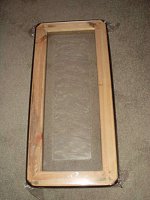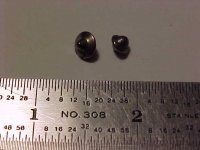You are the first person, other than myself, that I know of to try this method of diaphragm stretching.
I also use it, with good results. This is the smaller of two which I made, this one for a Quad ESL-57 treble panel.
Tim.
Attachments
Yesterday I tackled the problem of deburring hundreds or thousands of holes in perforated steel stators. After doing six holes by hand, I figured there had to be a better way.
Two ways came to mind, electrochemical deburring and media deburring. A google search and some web surfing led me to this page about producing rust on steel. It's not deburring, but I reasoned the rust had to come from somewhere and a sharp edge was probably the first to turned to rust.
Several posts down was this:
Method 1. --------- You'll need a source of DC electricity, a tub of water and some salt (maybe a tablespoon). Connect a piece of steel to the positive output from your DC source, stick that in the water, and then stick the negative output into the water (but don't let the two touch). Switch on your power supply and let it sit, I usually do this overnight.
And later was this post:
The electrolysis processes described above pose a very serious health risk. The salt molecules used in the water mixture between the two poles are broken apart by this charge, breaking the sodium chloride into its component parts: sodium and chlorine gas.
I started with a 3" x 5" piece of perforated steel in vinegar with a stainless steel wire as the other electrode and fired it up with a low curent adjustable DC power supply. At 20 volts it was drawing 50 ma and showing small bubbles coming from the stainless steel. No joy, after an hour the steel was clean, but not deburred at all.
Out went the vinegar and small power supply and in came the salt water and 12 volt battery charger. 😀 2 amps current this time and almost immediately the water turned a dirty brown. I'm making rust! At 15 minutes, the water started to heat up and the current went up to 3 amps. Heat and current kept rising until I shut it off at 30 minutes and 5 amps. There was a clearly delineated layer of suspended rust with about 1/2" of brown water above it in the container. The battery charger was beginning to smell of burning insulation. I don't know much about chemistry, but I do know I didn't want to let the magic smoke out of my battery charger.
The results were not encouraging. The steel that was close to the stainless steel electrode was noticeably eaten away, but the sharp edges a mere 1/4" away were unaffected. I don't think this will be a reasonable DIY solution.
The next try is media deburring in a tumbling barrel. I have access to a barrel similar to this. I've done a sample with steel shot media that worked quite well, but the shot was the same size as the perforations and seemed to get stuck in the holes.
I need to change the media and try again. Here's a picture of the media that should work better:
Two ways came to mind, electrochemical deburring and media deburring. A google search and some web surfing led me to this page about producing rust on steel. It's not deburring, but I reasoned the rust had to come from somewhere and a sharp edge was probably the first to turned to rust.
Several posts down was this:
Method 1. --------- You'll need a source of DC electricity, a tub of water and some salt (maybe a tablespoon). Connect a piece of steel to the positive output from your DC source, stick that in the water, and then stick the negative output into the water (but don't let the two touch). Switch on your power supply and let it sit, I usually do this overnight.
And later was this post:
The electrolysis processes described above pose a very serious health risk. The salt molecules used in the water mixture between the two poles are broken apart by this charge, breaking the sodium chloride into its component parts: sodium and chlorine gas.
I started with a 3" x 5" piece of perforated steel in vinegar with a stainless steel wire as the other electrode and fired it up with a low curent adjustable DC power supply. At 20 volts it was drawing 50 ma and showing small bubbles coming from the stainless steel. No joy, after an hour the steel was clean, but not deburred at all.
Out went the vinegar and small power supply and in came the salt water and 12 volt battery charger. 😀 2 amps current this time and almost immediately the water turned a dirty brown. I'm making rust! At 15 minutes, the water started to heat up and the current went up to 3 amps. Heat and current kept rising until I shut it off at 30 minutes and 5 amps. There was a clearly delineated layer of suspended rust with about 1/2" of brown water above it in the container. The battery charger was beginning to smell of burning insulation. I don't know much about chemistry, but I do know I didn't want to let the magic smoke out of my battery charger.
The results were not encouraging. The steel that was close to the stainless steel electrode was noticeably eaten away, but the sharp edges a mere 1/4" away were unaffected. I don't think this will be a reasonable DIY solution.
The next try is media deburring in a tumbling barrel. I have access to a barrel similar to this. I've done a sample with steel shot media that worked quite well, but the shot was the same size as the perforations and seemed to get stuck in the holes.
I need to change the media and try again. Here's a picture of the media that should work better:
Attachments
Deburr
Hi,
why not try a Hydrochloric-Acid solution? Handling with Salty-water isn´t much healthier either! In Germany You can get 30%-HCL solution in nearly every DIY-market. The surface treatment by the acid should provide for a better sticking of the insulation to the metal too.
jauu
Calvin
Hi,
why not try a Hydrochloric-Acid solution? Handling with Salty-water isn´t much healthier either! In Germany You can get 30%-HCL solution in nearly every DIY-market. The surface treatment by the acid should provide for a better sticking of the insulation to the metal too.
jauu
Calvin
- Status
- Not open for further replies.

